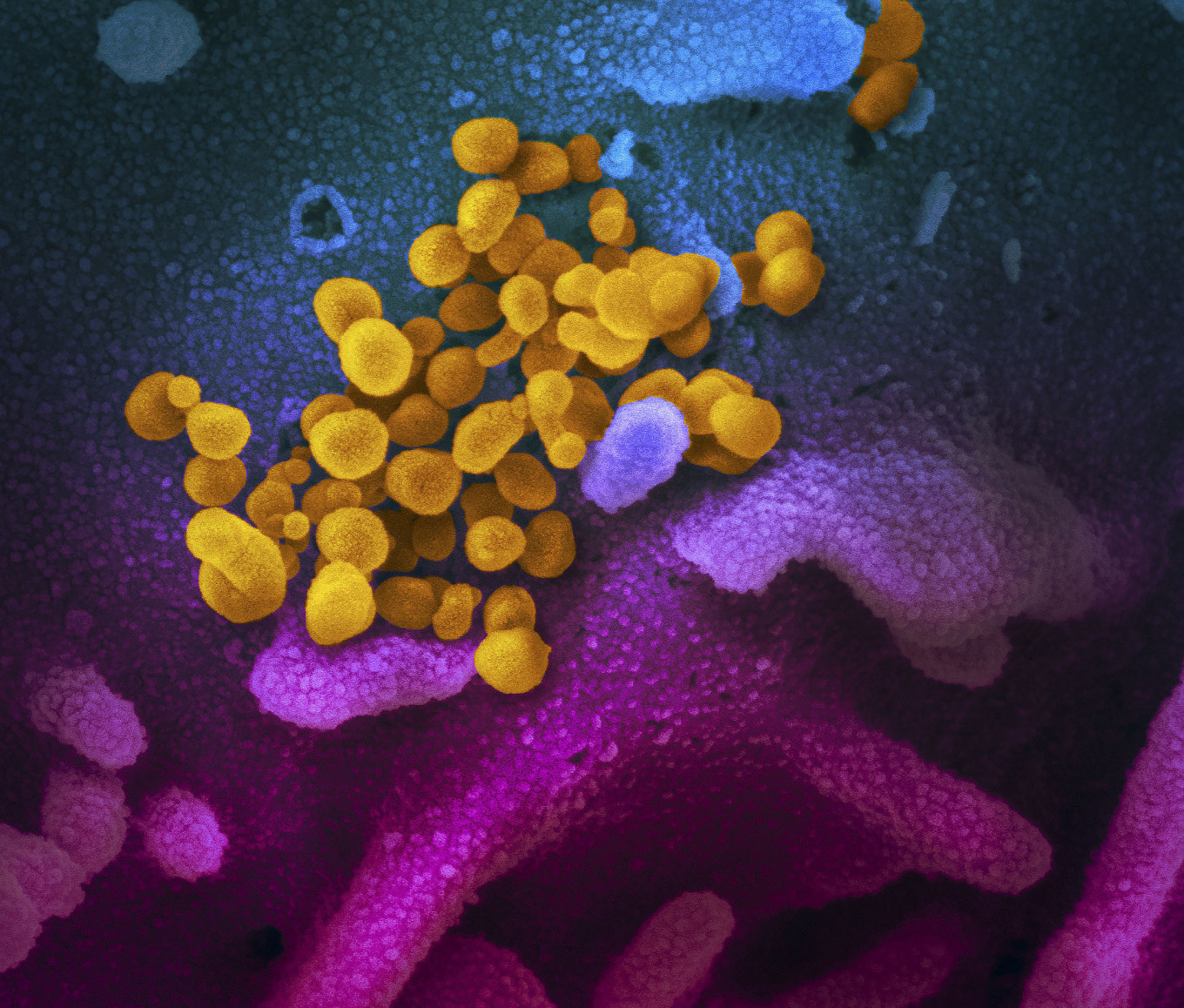Popular Reads
Top Results
Can't find what you're looking for?
View all search resultsPopular Reads
Top Results
Can't find what you're looking for?
View all search resultsAirborne transmission unlikely to be big driver of COVID-19, says expert
The experts agree on this: COVID-19 does not spread the same way a typical airborne virus does - floating down the streets for many hours and infecting people as it moves in and out of homes.
Change text size
Gift Premium Articles
to Anyone
 This file photo handout illustration image obtained Feb. 27, 2020 courtesy of the National Institutes of Health taken with a scanning electron microscope shows SARS-CoV-2 (yellow)—also known as 2019-nCoV, the virus that causes COVID-19—isolated from a patient in the US, emerging from the surface of cells (blue/pink) cultured in the lab. (AFP/National Institutes of Health/Handout)
This file photo handout illustration image obtained Feb. 27, 2020 courtesy of the National Institutes of Health taken with a scanning electron microscope shows SARS-CoV-2 (yellow)—also known as 2019-nCoV, the virus that causes COVID-19—isolated from a patient in the US, emerging from the surface of cells (blue/pink) cultured in the lab. (AFP/National Institutes of Health/Handout)
W
hile the World Health Organization (WHO) acknowledged the possibility of airborne transmission of COVID-19 last week, this is unlikely to be a big driver of the disease, says a WHO representative and senior infectious diseases expert here.
Professor Dale Fisher, who chairs the WHO's Global Outbreak and Alert and Response Network (Goarn), said last Thursday that the agency maintains that the virus is spread mostly by contact and droplet spread.
"Outside of the hospital, we really don't see it [airborne transmission] as a big driver... That's where we stand," said Prof Fisher, a senior infectious diseases consultant at the National University Hospital.
Agreeing, Associate Professor Hsu Li Yang, program leader for infectious diseases at the National University of Singapore's (NUS) Saw Swee Hock School of Public Health, pointed out that the transmission of COVID-19 occurs in a continuum.
"The reality is that respiratory viruses are present in droplets both large and small.
"While the transmission is predominantly by close contact and droplets [larger particles that don't remain airborne for long], there are circumstances under which airborne transmission occurs, such as medical procedures or activities such as singing that generate more aerosols, or in poorly ventilated and crowded rooms."
Only a very small number of diseases are believed to be spread via aerosols, or tiny floating particles. These include measles and tuberculosis - two highly contagious pathogens that can linger in the air for hours and require extreme precautions to prevent exposure.
The experts agree on this: COVID-19 does not spread the same way a typical airborne virus does - floating down the streets for many hours and infecting people as it moves in and out of homes.
Some researchers have said, however, that the virus does travel much farther than the 1m to 2m expected of a droplet-borne illness, putting people in prolonged contact at close range, especially indoors, at risk.
In its latest transmission guidance, the WHO had acknowledged that some outbreak reports related to indoor crowded spaces suggested the possibility of aerosol transmission, such as during choir practice, in restaurants or in fitness classes. But it added that more research is "urgently needed to investigate such instances and assess their significance for transmission of COVID-19".
This follows an open letter from scientists - including those who specialize in the spread of disease in the air - urging the world body to update its guidance on how the respiratory disease spreads to include aerosol transmission.
Prof Fisher discussed the recent development when he wrapped up a weekly COVID-19 webinar series organized by NUS, the National University Health System and Goarn.
He pointed out that COVID-19 has a much lower reproduction number than highly infectious airborne diseases like measles and chicken pox.
"We know that the vast majority of people who get COVID-19 get it from close contact, and the reproductive number is generally around 2.5."
In comparison, airborne diseases such as measles and chickenpox have higher reproductive numbers of 10 to 15.
The researchers behind the letter - the 239 include engineers, physicians and aerosol scientists - said the virus does travel much farther than the 1m to 2m that people have been told to expect of COVID-19, putting everyone in prolonged contact at close range, especially indoors, at risk.
They said that infected people produce tiny aerosols and larger droplets, and there is no need to distinguish between the two.
Said Prof Fisher: "We generally go with the theory that it's contact and droplet [transmission] so, therefore, wash your hands, keep your distance, wear a mask, particularly if you can't keep that distance."
In Singapore, the National Centre for Infectious Diseases has said it is studying whether the coronavirus is naturally airborne and infectious in such a form, though the results are not expected to affect current measures.






